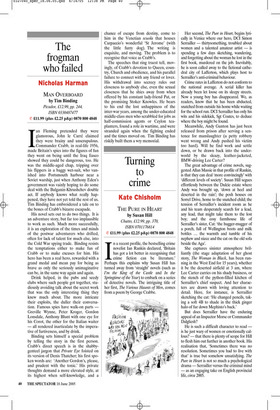Turning to crime
Kate Chisholm
THE PURE IN HEART by Susan Hill Chatto, £12.99, pp. 370, ISBN 0701176814 ✆ £11.99 (plus £2.25 p&p) 0870 800 4848 In a recent profile, the bestselling crime novelist Ian Rankin declared, ‘Britain has got a lot better in recognising that crime fiction can be literature.’ Perhaps this explains why Susan Hill has turned away from ‘straight’ novels (such as I’m the King of the Castle and In the Springtime of the Year) to embark on a series of detective novels. The intriguing title of her first, The Various Haunts of Men, comes from a poem by George Crabbe. Her second, The Pure in Heart, begins lyrically in Venice where our hero, DCI Simon Serrailler — thirtysomething, troubled about women and a talented amateur artist — is spending a few days sketching, wandering, and forgetting about the woman he lost in the first book, murdered on the job. Inevitably, he is soon called away to the fictional cathedral city of Lafferton, which plays host to Serrailler’s anti-criminal behaviour.
Crime rates in Lafferton do not conform to the national average. A serial killer has already been let loose on its sleepy streets. Now a young boy has disappeared. We, as readers, know that he has been abducted, snatched from outside his home while waiting for the school run. DCI Serrailler has only his wits and his sidekick, Sgt Coates, to deduce where the boy might be found.
Meanwhile, Andy Gunton has just been released from prison after serving a sentence for manslaughter (a petty robbery went wrong and Andy pushed his victim too hard). Will he find work and settle down, or be drawn back into the underworld by the sleazy, leather-jacketed, BMW-driving Lee Carter?
The great advantage of crime novels, suggested Allan Massie in that profile of Rankin, is that they can deal ‘more convincingly’ with ‘different levels of society’. Susan Hill segues effortlessly between the Dulcie estate where Andy was brought up, ‘down at heel and deserted in the rain’; the posh houses on Sorrel Drive, home to the snatched child; the tension of Serrailler’s incident room as he and his team desperately search for a lead, any lead, that might take them to the lost boy; and the cosy farmhouse life of Serrailler’s sister, Cat: ‘the hugger-mugger of a porch, full of Wellington boots and milk bottles ... the warmth and tumble of his nephew and niece and the cat on the old sofa beside the Aga’.
She captures sinister atmosphere brilliantly (the stage adaptation of her ghost story, The Woman in Black, has been running in the West End for 15 years), whether it be the deserted airfield at 3 am, where Lee Carter carries on his shady business, or the stench of the python-filled kitchen of Serrailler’s chief suspect. And her characters are drawn with loving attention to detail. Here, for instance, is Serrailler sketching the cat: ‘He changed pencils, taking a soft 4B to shade in the thick ginger halo of fur down Mephisto’s back.’ But does Serrailler have the enduring appeal of an Inspector Morse or Commander Dalgliesh?
He is such a difficult character to read is he just wary of women or emotionally callous? — that there is plenty of scope for Hill to flesh him out further in another book. His realisation that, ‘Sometimes there was no resolution. Sometimes you had to live with that’ is true but somehow unsatisfying. The Pure in Heart is not so much a psychological drama — Serrailler versus the criminal mind — as an engaging take on English provincial life, circa 2005.
















































 Previous page
Previous page